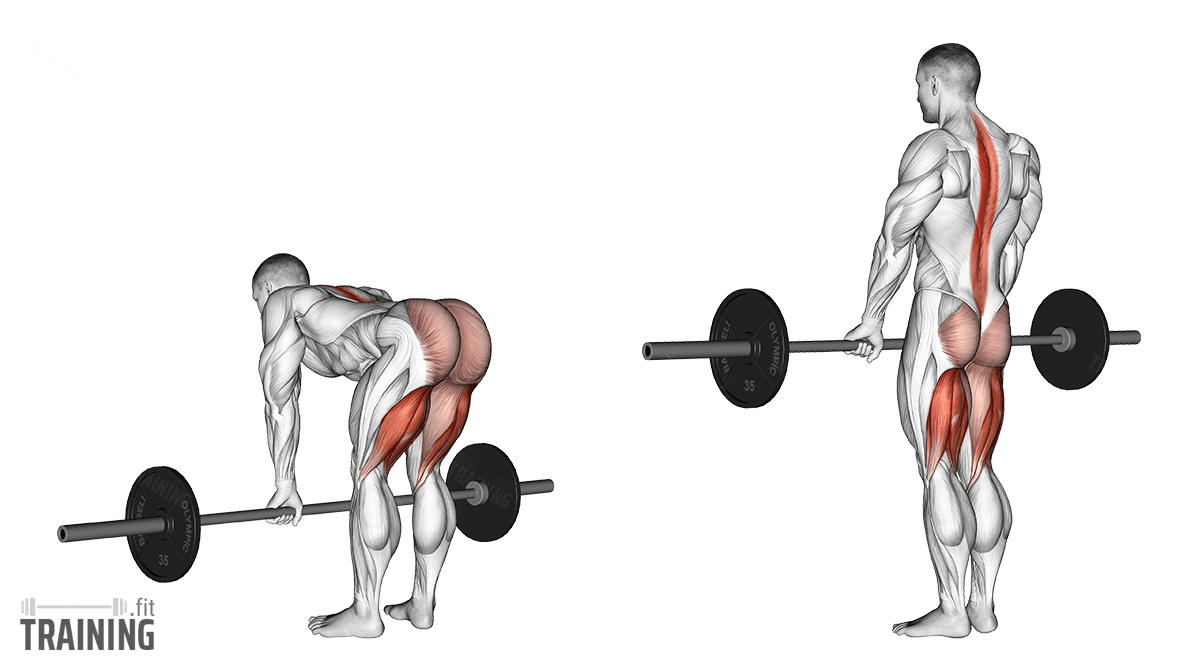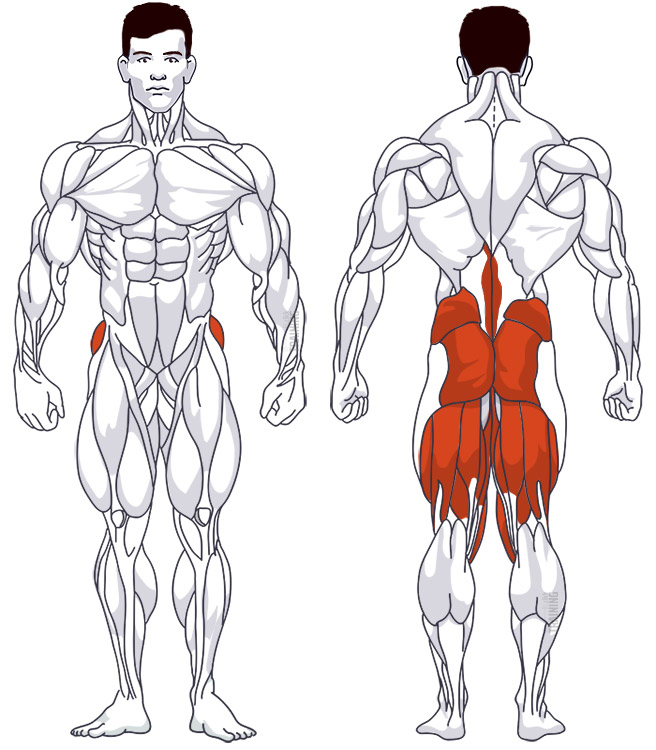Romanian Deadlift
Compound exercise, Free weightsOverview

Main muscles
- Thigh: Thigh flexor
(Musculus biceps femoris) - Buttocks: Large gluteus maximus
(Musculus gluteus maximus) - Back: Back extensor
(Musculus erector spinae)
Romanian Deadlift: Basics and alternatives

Involved main muscle groups:
Romanian Deadlift
Just like the classic deadlift, the Romanian deadlift (also known as the “straight leg deadlift”) is one of the most challenging exercises in strength training.
Despite its name, the muscle focus on the lower back and hamstrings is similar to the Good Mornings, as well as the movement pattern. With straight legs, you bend your upper body while keeping your back straight, and then straighten up again. Unlike the Good Mornings, the weight in the Romanian deadlift is not on your shoulders or neck but in front of your body.
Compared to the regular deadlift, the movement pattern is much more limited, which significantly reduces thigh muscle training. Nevertheless, the straight leg deadlift is a tough exercise that requires extra care to prevent back injuries.
You can also try Romanian deadlifts with dumbbells, or check out the Sumo deadlift and cable pull deadlift. The classic deadlift and Good Mornings have already been mentioned. For beginners, simpler exercises include back extensions with or without equipment.
Correct Execution
As with the regular deadlift, it’s a good idea to start your first training session with just the barbell – without additional weights. This allows you to focus on the movement pattern and practice without added load.
Although the Romanian deadlift is performed with straight legs, you still need to lift the barbell from the ground. Pay attention to proper form when lifting the weight, keeping your back straight and lifting with your legs. Avoid rounding your back when lifting the weight, as this can strain your discs and increase your risk of injury.
The same goes for the actual exercise: Always maintain a straight back and stop the movement before your back starts to round. This is a potential source of error not only when lifting the weight but also during the exercise.
Video tutorial
Step-by-Step Instructions
Stand in front of the barbell on the ground, about shoulder-width apart.
Slightly bend your knees, keeping your back straight. Grab the barbell with an overhand grip (palms facing up/forward, thumbs pointing towards each other).
Lift the barbell with a straight back, using your legs. Stand up normally, with the barbell in an overhand grip in front of your thighs.
Straighten your back, creating a slight arch. Pull your shoulders back a bit and keep your head upright. You’re now in the starting position.
Bend your upper body at the hips in a controlled manner, keeping your legs straight. Slide the barbell down your legs.
Stop bending when you feel a stretch in your hamstrings, or when bending further would require rounding your lower back. Avoid bending your back.
Then, straighten your upper body back into the starting position. Throughout the entire movement, keep your back straight and your legs straight.
Common Mistakes and Injuries
Rounding the back is the biggest and most dangerous mistake when performing the straight leg deadlift. Ensure that your lower back has a slight arch throughout the entire movement and that your entire back forms a straight line. Avoid rounding your back, which can occur if the weight is too heavy, you’re not paying attention, or you’re bending your upper body too far forward.
The lower back is particularly prone to disc problems with such high loads. Therefore, it’s important to practice the exercise without additional weight at the beginning to ensure a smooth training process.